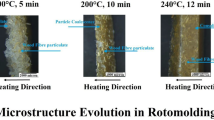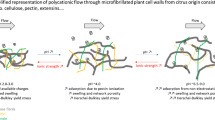Abstract
The uptake of solutions of sodium hydroxide by lyocell fibre results in a phenomenon in textiles described as swelling–shrinkage. The response of woven fabrics in a tensile stress–relaxation experiment shows two time-dependent processes, corresponding to different mechanisms of pressure development. Rapid diffusion has been assigned to osmotic swelling through the interconnected pore structure of the fibre (D = 6–15 × 10−12 m2/s), which is influenced by the extent of ionization of hydroxyl groups at the pore surfaces. A ratio for the cellulose and water dissociation constants (Kcell/Kw) of 70 provides best agreement with experimental data. A second slower diffusion process (D = 2–10 × 10−14 m2/s) is assigned to transport through the cellulose polymer structure, associated with the Na-cellulose transition. This can be modeled assuming an ion-exchange equilibrium, where the cellulose gel converts reversibly between compact hydrogen and expanded sodium forms, with K = 1.04 × 1014, in favour of the hydrogen form. The model successfully predicts the concentration dependence of the transition and the movement to higher concentration with external constraint. The slow diffusion process only becomes apparent at high alkali concentrations, as the pores in the fibre collapse due to the expansion of the gel. Continued gel-diffusion is only possible through the polymer phase, which then dominates over fast pore-diffusion.














Similar content being viewed by others
References
Abu-Rous M, Ingolic E, Schuster KC (2006) Visualisation of the fibrillar and pore morphology of cellulosic fibres applying transmission electron microscopy. Cellulose 13:411–419
Bird CL, Boston WS (1975) (eds) The theory of colouration of textiles. Chapter 5 by Jones F. The Dyers Company Publications, Trust, Bradford UK
Colom X, Carillo F (2002) Crystallinity changes in lyocell and viscose-type fibres by caustic treatment. Eur Polym J 38:2225–2230
Crawshaw J, Cameron RE (2000) A small angle X-ray scattering study of the pore structure in Tencle cellulose fibres and the effects of physical treatments. Polymer 41:4691–4698
Donnan FG (1934) Z physik Chem 168A:369
Eichhorn SJ, Young RJ, Davies GR (2005) Modeling crystal and molecular deformation in regenerated cellulose fibers. Biomacromolecules 6:507–513
Fieldson GT Barbari TA (1993) The use of FTIR-ATR spectroscopy to characterize penetrant diffusion in polymers. Polymer 34(6):1146–1153
Fink H-P, Weigel P, Purz H-J, Ganster J (2001) Structure formation of regenerated cellulose materials from NMMO-solutions. Prog Polym Sci 26:1473–1524
Glueckauf E (1952) A theoretical treatment of cation exchangers I. The prediction of equilibrium constants from osmotic data. Proc Roy Soc A 214(1117):207–225
Gregor HP (1951) Gibbs-Donnan equilibria in ion exchange resin systems. J Am Chem Soc 73:642–650
Hearles JWS, Miles LWC (1971) The setting of fibres and fabrics. Merrow Publishing Co Ltd, Watford, UK
Hodson S, Earlam R (1993) The incorporation of gel pressure into the irreversible thermodynamic equation of fluid flow in order to explain biological tissue swelling. J Theor Biol 163:173–180
Ibbett (1996) Tencel Ltd Internal report
Ibbett RN, Hsieh Y-L (2001) Effect of fibre swelling on the structure of lyocell fabrics. Text Res J 71(2):164–173
Ibbett RN, Fashing M, Domvoglou D (2007) Characterisation of the supramolecular structure of chemically and physically modified regenerated cellulosic fibers by means of high-resolution Carbon-13 solid state NMR. Polymer 48:1287–1296
Kawai T (1959) Sorption of water vapor by cellulose and polymers at high humidities. J Polym Sci 37:181–198
Kolpak FJ, Weih M, Blackwell J (1978) Mercerisation of cellulose: l. Determination of the structure of mercerized cotton. Polymer 19:123–131
Laity PR, Gover PM, Godward J, McDonald PJ, Hay JN (2000) Structural studies and diffusion measurements of water-swollen cellophane by NMR Imaging. Cellulose 7:227–246
Lenz J, Schurz J, Eichinger D (1994) Properties and structure of lyocell and viscose-type fibres in the swollen state. Lenzinger Berichte 74:19–25
Moss CE, Butler MF, Müller M, Cameron RE (2002) Microfocus small-angle X-ray scattering investigation of the skin-core microstructure of lyocell cellulose fibers. J Appl Polym Sci 83:2799–2816
Neale SM (1929) J Textile Inst 20:T373
Nishimura H, Sarko A (1987) Mercerisation of cellulose III. Changes in crystallite sizes. J Appl Polym Sci 33:855–866
Nishimura H, Sarko A (1991b) Mercerisation of cellulose 6. Crystal and molecular structure of Na-cellulose IV. Macromolecules 24:771–778
Nishimura H, Okano T, Sarko A (1991a) Mercerisation of cellulose 5. Crystal and molecular structure of Na-cellulose-I. Macromolecules 24:759–770
Okano T, Sarko A (1984) Mercerisation of cellulose. I X-ray diffraction evidence for intermediate structures. J Appl Polym Sci 29:4175–4182
Okano T, Sarko A (1985) Mercerisation of cellulose. II Alkali-cellulose intermediates and a possible mercerization mechanism. J Appl Polym Sci 30:325–332
Paterson R (1970) An introduction to ion-exchange. Hayden and Son Ltd, London
Pennings AJ, Prins W (1962) The polyelectrolyte nature of cellulose gels in alkali solutions. J Polym Sci 58:229–248
Pierce FT (1937) The geometry of cloth structure. J Textile Inst 28:45–96
Preston C (1986) (ed) The Dyeing of Cellulosic Fibres. Chapter 3. by Holme I, Dyers’ Company Publications Trust, Bradford UK
Scallan AM, Grignon J (1980) Effect of pH and neutral salts upon the swelling of cellulose gels. J Appl Polym Sci 25:2829–2843
Schurz J, Lenz J (1994) Investigation of the structure of regenerated cellulose fibres. Macromol Symp 83:273–289
Tarfaoui M, Akesbi S (2001) Study of the mechanical behaviour of textile structures. Int J Clothing Sci Technol 13:166–175
Yokota H, Sei T, Horii F, Kitamaru R (1990) 13C CP/MAS NMR study on alkali cellulose. J App Pol Sci 41:783–791
Zhang W, Okubayashi S, Bechtold T (2005) Fibrillation tendency of cellulosic fibers. Part 1: effects of swelling. Cellulose 12(3):267–273
Zhu Y, Ren X, Wu C (2004) Influence of alkali treatment on the structure of newcell fibres. J Appl Polym Sci 93:1731–1735
Author information
Authors and Affiliations
Corresponding author
Rights and permissions
About this article
Cite this article
Ibbett, R., Taylor, J., Schuster, K.C. et al. Interpretation of relaxation and swelling phenomena in lyocell regenerated cellulosic fibres and textiles associated with the uptake of solutions of sodium hydroxide. Cellulose 15, 393–406 (2008). https://doi.org/10.1007/s10570-007-9180-6
Received:
Accepted:
Published:
Issue Date:
DOI: https://doi.org/10.1007/s10570-007-9180-6




